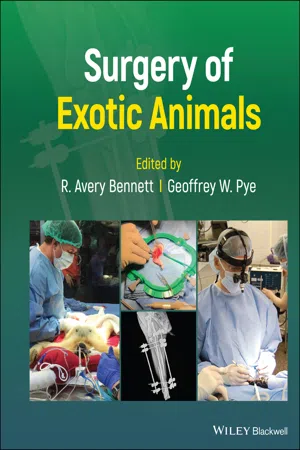
- English
- ePUB (mobile friendly)
- Available on iOS & Android
Surgery of Exotic Animals
About this book
The first book to provide veterinarians with in-depth guidance on exotic animal surgical principles and techniques
As the popularity of exotic animals continues to grow, it is becoming increasingly important for veterinarians to be knowledgeable and skilled in common surgical procedures for a wide range of exotic species. Written for practitioners and board-certified surgeons with a working knowledge of domestic animal surgery, Surgery of Exotic Animals is the first clinical manual to provide comprehensive guidance on surgical principles and common procedures in exotic pets, zoo animals, and wildlife.
Edited by internationally recognized leaders in exotic animal surgery and zoological medicine, this much-needed volume covers invertebrates, fish, amphibians, reptiles, birds, and both terrestrial and marine mammals. Contributions from a team of surgery and zoo specialists offer detailed descriptions of common surgeries and provide a wealth of color images demonstrating how each procedure is performed—including regional anatomy and surgical approaches. An invaluable one-stop source of authoritative surgical information on exotic species, this book:
- Provides illustrated guidance on surgical principles and common surgeries performed in exotic species
- Describes general principles, instrumentation, equipment, suture materials, and magnification surgery
- Covers a wide range of procedures such as small and large mammal dental surgery, avian soft tissue surgery, reptile orthopedic surgery, and primate surgery
- Includes chapters on surgical oncology, megavertebrate laparoscopy, and minimally invasive surgery techniques
Surgery of Exotic Animals is an indispensable clinical guide and reference for all private veterinary practitioners; exotic, zoo, and wildlife veterinarians; laboratory animal veterinarians; veterinary students; and veterinary technicians.
Frequently asked questions
- Essential is ideal for learners and professionals who enjoy exploring a wide range of subjects. Access the Essential Library with 800,000+ trusted titles and best-sellers across business, personal growth, and the humanities. Includes unlimited reading time and Standard Read Aloud voice.
- Complete: Perfect for advanced learners and researchers needing full, unrestricted access. Unlock 1.4M+ books across hundreds of subjects, including academic and specialized titles. The Complete Plan also includes advanced features like Premium Read Aloud and Research Assistant.
Please note we cannot support devices running on iOS 13 and Android 7 or earlier. Learn more about using the app.
Information
1
General Principles, Instruments, and Equipment
Introduction
Presurgical Considerations
Patient Support
Data Base
Preoperative Fasting
Hemodynamic Support
Table of contents
- Cover
- Table of Contents
- Title Page
- Copyright Page
- Dedication Page
- List of Contributors
- Preface
- About the Editors
- 1 General Principles, Instruments, and Equipment
- 2 Suture Materials
- 3 Magnification Surgery
- 4 Invertebrate Surgery
- 5 Fish Surgery
- 6 Amphibian Surgery
- 7 Reptile Orthopedic Surgery
- 8 Surgical Approaches to the Reptile Coelom
- 9 Reptiles
- 10 Avian Orthopedics
- 11 Approaches to the Caudal Coelom (Abdomen) of Birds
- 12 Avian Reproductive Procedures
- 13 Surgery of the Avian Gastrointestinal Tract
- 14 Surgery of the Avian Respiratory System and Cranial Coelom
- 15 Minimally Invasive Surgery Techniques in Exotic Animals
- 16 Orthopedic Surgery in Small Mammals
- 17 Rabbit Soft Tissue Surgery
- 18 Ferret Soft Tissue Surgery
- 19 Rodent Soft Tissue Surgery
- 20 Soft Tissue Surgery in Hedgehogs
- 21 Surgery of the Sugar Glider
- 22 Small Mammal Dental Surgery
- 23 Large Mammal Dental Surgery
- 24 Primate Surgery
- 25 Marine Mammal Surgery
- 26 Megavertebrate Laparoscopy
- 27 Zoo Animal Surgery
- 28 Surgical Oncology in Exotics
- Index
- End User License Agreement